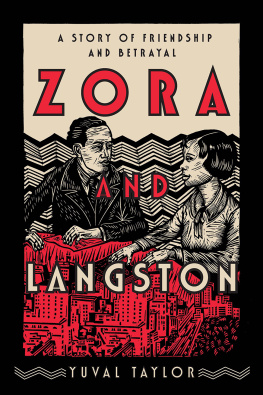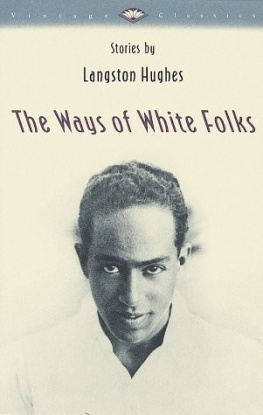The George Gund Foundation has endowed this imprint to advance understanding of the history, culture, and current issues of African Americans.
The publisher gratefully acknowledges the generous support of the African American Studies Endowment Fund of the University of California Press Foundation, which was established by a major gift from the George Gund Foundation.
Letters from Langston
FROM THE HARLEM RENAISSANCE TO THE RED SCARE AND BEYOND
EDITED BY
Evelyn Louise Crawford and MaryLouise Patterson
With a foreword by Robin D.G. Kelley

UNIVERSITY OF CALIFORNIA PRESS
University of California Press, one of the most distinguished university presses in the United States, enriches lives around the world by advancing scholarship in the humanities, social sciences, and natural sciences. Its activities are supported by the UC Press Foundation and by philanthropic contributions from individuals and institutions. For more information, visit www.ucpress.edu.
University of California Press
Oakland, California
2016 by Evelyn Louise Crawford
Cross, Lenin, Merry-Go-Round, One-Way Ticket, Jim Crows Last Stand, Southern Mammy Sings, The Black Man Speaks, High to Low, Postcard from Spain, When the Armies Passed, Lumumbas Grave, Low to High, Salute to the Soviet Armies, Ballad of Ozie Powell, First of May, Governor Fires Dean, Poem to Uncle Sam, Message to the President, Total War, and Just an Ordinary Guy from The Collected Poems of Langston Hughes by Langston Hughes, edited by Arnold Rampersad with David Roessel, Associate Editor, copyright 1994 by the Estate of Langston Hughes. Used by permission of Alfred A. Knopf, an imprint of the Knopf Doubleday Publishing Group, a division of Penguin Random House LLC. All rights reserved.
Library of Congress Cataloging-in-Publication Data
Hughes, Langston, 19021967, author.
[Correspondence. Selections. (Crawford and Patterson)]
Letters from Langston : from the Harlem Renaissance to the Red Scare and beyond / edited by Evelyn Louise Crawford and MaryLouise Patterson ; with a foreword by Robin D.G. Kelley.
pages cm
Includes bibliographical references and index.
ISBN 978-0-520-28533-0 (cloth : alk. paper)
ISBN 978-0-520-28534-7 (pbk. : alk. paper)
ISBN 978-0-520-96086-2 (ebook)
1. Hughes, Langston, 1902-1967Correspondence. 2. Authors, American20th centuryCorrespondence. 3. African American authorsCorrespondence. I. Crawford, Evelyn Louise, editor. II. Patterson, MaryLouise, 1943 editor. III. Title.
PS3515.U274Z48 2016
818.5209dc23
[B]
2015029780
Manufactured in the United States of America
24 23 22 21 20 19 18 17 16
10 9 8 7 6 5 4 3 2 1
In keeping with a commitment to support environmentally responsible and sustainable printing practices, UC Press has printed this book on Natures Natural, a fiber that contains 30% post-consumer waste and meets the minimum requirements of ANSI/NISO Z 39.48-1992 ( R 1997) ( Permanence of Paper ).
In loving memory of Langston, Louise, Pat, Nebby, and Matt
AND
our dearly missed children, Razak Bello and Sandra Camacho
CONTENTS
LIST OF ILLUSTRATIONS
FOREWORD
Robin D.G. Kelley
Langston Hughes has become a household name. An icon of the Harlem Renaissance, the subject of numerous biographies, and one of the bona fide deans of African American letters, Hughes may be the best-known American poet after Robert Frost or Walt Whitman. But to characterize Letters from Langston as simply another epistolary window into the life and times of the Black Bard would be both a mistake and a grave injustice to the entire enterprise. Letters from Langston is a book of correspondence between five extraordinary people who sustained an extraordinary friendship during extraordinary timeslovingly and painstakingly reconstructed by Evelyn Louise Crawford and MaryLouise Patterson, who were, in more ways than one, the offspring of these relationships.
Careful readers of Hughess biography will be familiar with Louise Thompson, the brilliant organizer, writer, and orator who became Langstons closest confidante. In her capacity as secretary of the Harlem chapter of the Friends of the Soviet Union, Louise led a large delegation of Black artists to the Soviet Union in 1932 to participate in a film about racial conditions in America. Though the film was aborted, she was thereafter dubbed Madame Moscow. Many readers will also recognize the name of William L. Patterson, Louises husband and one of the United States highest-ranking Black Communists. Pat, as he was called by his friends, is perhaps best known for authoring We Charge Genocide, a searing indictment of American racism, published in 1951. Matt and Evelyn Nebby Crawford are perhaps less known, but they are no less significant. Matt gave up a promising career as a doctor to become a full-time organizer as a labor leader, a Communist, and a fighter for racial justice. His wife, Nebby, never joined the party, but she did support struggles for racial and economic justice in the San Francisco Bay Area, where they lived, and she remained an avid, intelligent interlocutor within her circle of radical friends until her untimely death in 1972.
The Pattersons and the Crawfords were nothing like the working-class folk characters one finds in Hughess poetryexcept for their chronic financial struggles, and that was by choice. Each family had been poised to lead a comfortable, middle-class existencebounded by Jim Crow laws, of course. They had everything: education, professional contacts and experience, and loads of opportunities. At some point in their respective lives, each stood in the eye of the cultural tornado we now call the Harlem Renaissance. Their circle of friends included W.E.B. Du Bois, Paul and Essie Robeson, Zora Neale Hurston, Aaron Douglas, and others. Louise, Pat, Matt, and Nebby were fine writers, excellent orators, and voracious readers, never bound by the limits of their community, race, or country. They could have become renowned scholars or mainstream Negro leaders. Instead, they independently chose to cast their fate with what would become the most despised movement in America: Communism.
Why? Because they believed that, through relentless global struggle, another world was possibleone that was free of class exploitation, racism, patriarchy, poverty, and injustice. They thought that an international socialist movement offered one of many possible paths to a liberated future. Through reading Marx and Engels and Lenin, they began to see the wretched of the earth with new eyes. As members of what Du Bois called the talented tenththe educated elite presumably destined to lead the raceLouise, Pat, Matt, and Nebby were renegades from a class known for its contempt of the Black poor. The main task of the Black middle class during the first half of the twentieth century was to uplift their race, prove to white folks that their education, manners, and good behavior made them worthy of citizenship, and avoid the pale faces that populated the lynch mobs and enjoyed the rights and privileges associated with the color of their skin. But the four chose instead to empathize with the plight of all Americans, including new European immigrants, Jews, and working-class whites, from whose lips the word nigger flowed easily. They shared their vision of multiracial proletarian unity with Langston Hughes, whose 1935 poem Let America Be America Again expressed, in bold cadences, their common dream to rise Out of the rack and ruin of our gangster death/The rape and rot of graft and to redeem/The land, the mines, the plants, the rivers./The mountains and the endless plain... And make America again! The letters in this book constitute a powerful and indisputable reminder of that vision and Hughess dedication to it, and of his Black radical comrades, who helped sustain that vision in spite of decades of police and FBI harassment, intimidation, violence, internal political dissension and intrigue, endless meetings, constant travel, and, in Pats case, imprisonment. Their letters reveal a shared worldview and a passionate political dedication to humanity.










